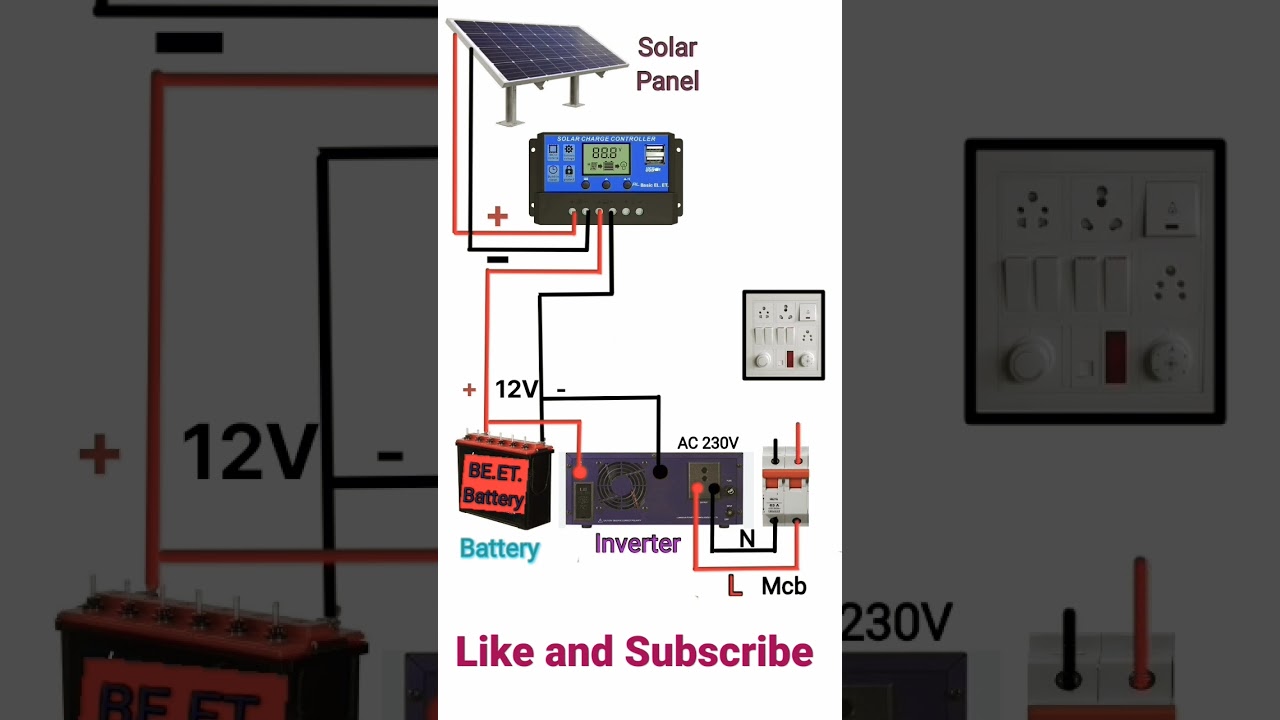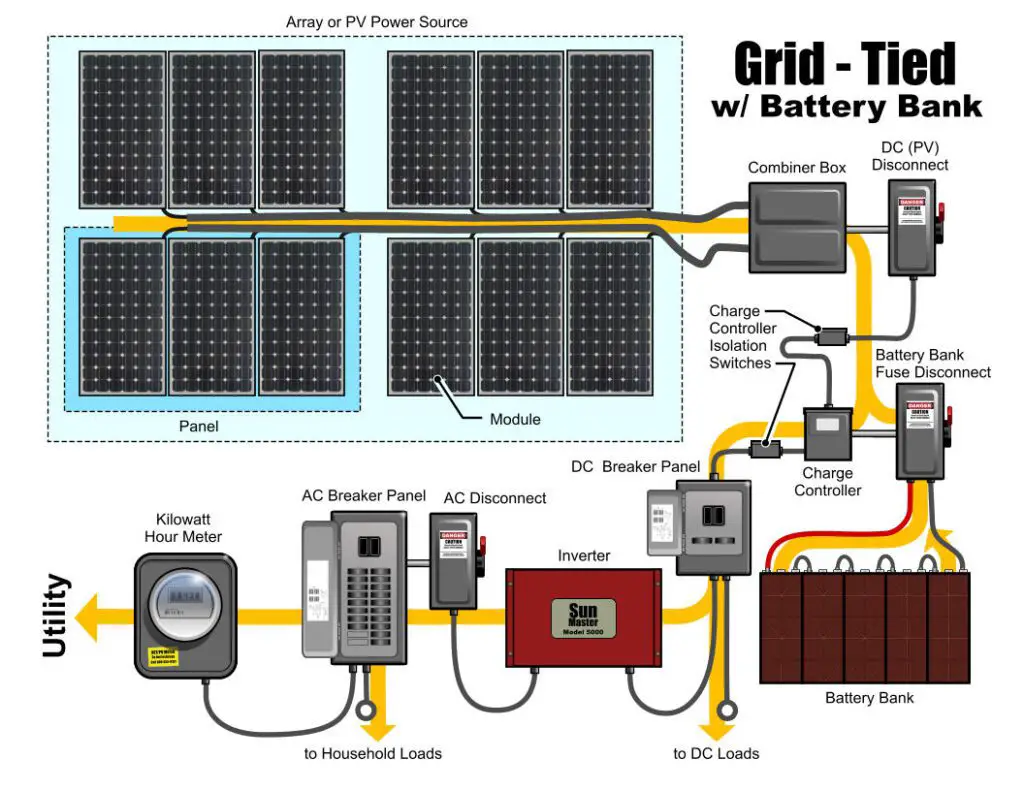“Solar panel and battery wiring explained”
Understanding the Basics of Solar Panel Wiring
Before we dive into the nitty-gritty of wiring, it’s essential to understand how solar panels work. A solar panel system consists of multiple photovoltaic (PV) panels that convert sunlight into electrical energy. The panels are connected in a series and/or parallel configuration to produce a specific voltage and current output. The energy generated by the solar panels is then fed into an inverter, which converts the DC (direct current) power into AC (alternating current) power, making it usable for homes and businesses.
Components of a Solar Panel Wiring System
A typical solar panel wiring system consists of the following components:
- Solar Panels: The photovoltaic panels that convert sunlight into electrical energy.
- Charge Controller: Regulates the energy flow from the solar panels to the batteries, preventing overcharging and ensuring the batteries are charged efficiently.
- Deep Cycle Batteries: Designed to store excess energy generated by the solar panels for later use.
- Inverter/Charger: Converts the DC power from the solar panels and batteries into AC power, and also charges the batteries from the grid or a generator.
- Wiring and Connectors: The conduits and connectors that link the various components of the system.
- Grounding System: A safety system that protects the system and its users from electrical shock.

Wiring Configurations for Solar Panels
There are several wiring configurations for solar panels, including:
- Series Wiring: Connecting solar panels in a series to increase the voltage output. This configuration is suitable for systems with a high voltage requirement.
- Parallel Wiring: Connecting solar panels in parallel to increase the current output. This configuration is suitable for systems with a high current requirement.
- Series-Parallel Wiring: A combination of series and parallel wiring, which offers a balance between voltage and current output.

Battery Wiring Explained

Batteries play a crucial role in a solar panel system, as they store excess energy generated by the solar panels for later use. The wiring of batteries is critical to ensure safe and efficient charging and discharging of the batteries.
- Battery Bank Configuration: Batteries can be connected in a series, parallel, or series-parallel configuration to achieve the desired voltage and capacity.
- Battery Charging: The charge controller regulates the energy flow from the solar panels to the batteries, ensuring they are charged efficiently and safely.
- Battery Monitoring: A battery monitoring system (BMS) is used to monitor the state of charge, voltage, and temperature of the batteries, ensuring they operate within a safe and efficient range.
Best Practices for Solar Panel and Battery Wiring
To ensure a safe and efficient installation, it’s essential to follow best practices for solar panel and battery wiring. These include:
- Use of Proper Wire Size: Using the correct wire size to minimize energy losses and ensure safe operation.
- Color Coding: Using color-coded wires to identify the different components and connections of the system.
- Proper Grounding: Ensuring the system is properly grounded to prevent electrical shock.
- Regular Maintenance: Regularly inspecting and maintaining the wiring system to prevent damage and ensure safe operation.
- Compliance with Local Regulations: Ensuring the installation complies with local electrical regulations and codes.
Safety Considerations for Solar Panel and Battery Wiring
Safety is paramount when working with electrical systems, and solar panel and battery wiring is no exception. Some safety considerations to keep in mind include:
- Electrical Shock: Ensuring the system is properly grounded and insulated to prevent electrical shock.
- Fire Risk: Ensuring the system is designed and installed to minimize the risk of fire.
- Overcharging: Ensuring the charge controller is properly configured to prevent overcharging of the batteries.
- Short Circuits: Ensuring the system is designed and installed to prevent short circuits and electrical arcing.
Tools and Materials Required for Solar Panel and Battery Wiring
To complete a solar panel and battery wiring installation, you’ll need the following tools and materials:
- Wiring and Connectors: A range of wires, connectors, and terminals to connect the various components of the system.
- Circuit Breakers and Fuses: To protect the system from electrical surges and short circuits.
- Grounding Equipment: To ensure the system is properly grounded.
- Test Equipment: To test the system and ensure it’s functioning correctly.
- Personal Protective Equipment: To ensure the safety of the installer.
Conclusion
Solar panel and battery wiring is a complex process that requires careful planning, design, and installation. By understanding the basics of solar panel wiring, the components of a solar panel system, and the best practices for wiring, you’ll be well on your way to designing and installing a safe and efficient solar panel system. Remember to always follow local regulations and codes, and to take necessary safety precautions to ensure a successful installation. With the right tools, materials, and knowledge, you can harness the power of the sun to provide clean, renewable energy for your home or business.
Recommendations for Further Learning
If you’re interested in learning more about solar panel and battery wiring, we recommend the following resources:
- National Electric Code (NEC): The NEC provides guidelines and standards for electrical installations, including solar panel systems.
- Solar Energy Industries Association (SEIA): The SEIA provides resources and guides for solar panel installations, including wiring and electrical connections.
- Online Courses and Tutorials: There are many online courses and tutorials available that provide in-depth training on solar panel and battery wiring.
- Industry Conferences and Workshops: Attend industry conferences and workshops to stay up-to-date with the latest developments and best practices in solar panel and battery wiring.
By following these recommendations and staying up-to-date with the latest developments in the field, you’ll be well on your way to becoming an expert in solar panel and battery wiring.





